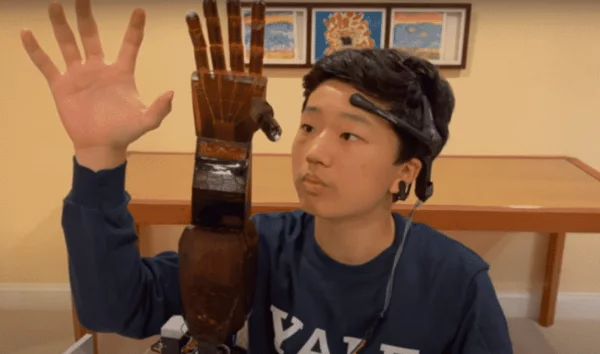By Ameya Paleja, Interesting Engineering
Benjamin Choi, a seventeen-year-old student from Virginia in the U.S., used the spare time offered by the pandemic to build a mind-controlled, artificial intelligence (A.I.) powered yet low-cost prosthetic arm, Smithsonian Magazine reported.
Back in 2020, Choi was a tenth-grader, looking to research aluminum fuels at a research lab in the summer. But when the pandemic struck, the lab was shut down, leaving Choi with plenty of time to spare. Inspired by a documentary he had seen almost a decade ago, Choi made a ping-pong table in his basement, a makeshift laboratory. And then he got to work building a low-cost prosthetic arm using his sister’s $75 3D printer and some fishing line.
How does the prosthetic arm work?
The 3D printer at Choi’s disposal could print pieces no bigger than 4.7 inches (~12 cm). So Choi had to print the arm in smaller pieces and put it all together with rubber bands. With previous experience building robots and programming, Choi also wrote the code for the device to work.
To avoid the need for complex brain surgeries, Choi’s system uses electroencephalography (EEG), a method that records the brain’s electrical activity with two sensors. One is a baseline sensor that clips to the earlobe while the other sits on the forehead and collects the EEG data. This information is sent to the prosthetic arm via Bluetooth and is then converted into meaningful action by the A.I. model that is embedded in a chip on the arm.
A.I. embedded on a chip
The A.I. model was built with the help of six volunteers who Choi worked with for over two hours each, collecting their brain data as they focused on clenching and unclenching their hands. Choi trained the A.I. to distinguish between the brain waves and learn from the user’s brain waves. Since A.I. models can get rather large, Choi toyed with the idea of storing them in the cloud. However, this method delayed the response time of the arm and also required the user to remain connected to the internet at all times.
So Choi compressed his algorithm, which has over 23,000 lines of code, 978 pages of math, and seven new sub-algorithms, onto a chip embedded in the arm. Six months into his project, Choi posted a video about his invention on YouTube, which caught the attention of an upper-limb amputee from Pennsylvania, Joseph Dunn, who has provided his input on the prosthetic design, while funding and technical supervision has also come in from the Massachusetts Institute of Technology.
How well does it work?
Two years into the project, Choi’s prosthetic arm has undergone over 75 iterations and is now made up of engineering-grade materials that could withstand a load of up to four tons. Choi claims his A.I-powered device has an accuracy of 95 percent, while commercial designs have achieved a maximum accuracy of 73.8 percent, Smithsonian said in its report.
Click here to read the full article on Interesting Engineering.



